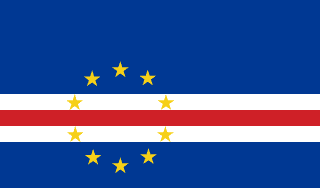Cape Verde - Geography

Here, let us take a look at the Geography of Cape Verde. Strategic location 500 km from west coast of Africa near major north-south sea routes; one of four North Atlantic archipelagos that make up Macaronesia; the others are Azores (Portugal), Canary Islands (Spain), and Madeira (Portugal). Mother's mean age at first birth is (), whereas, the Maternal mortality ratio is 42 deaths/100,000 live births (2020 est.)
Geographical data of Cape Verde
| Location | Western Africa, group of islands in the North Atlantic Ocean, west of Senegal |
|---|---|
| Geographic coordinates | 16 00 N, 24 00 W |
| Map references | Africa |
| Tarrain | steep, rugged, rocky, volcanic |
| Natural Resources | salt, basalt rock, limestone, kaolin, fish, clay, gypsum |
| Natural Hazards | prolonged droughts; seasonal harmattan wind produces obscuring dust; volcanically and seismically active volcanism: Fogo (2,829 m), which last erupted in 1995, is Cabo Verde's only active volcano |
| Irrigated Land | 35 sq km (2012) |
| Major rivers (by length in km) | |
| Major aquifers | |
| Land Boundaries | 0 km |
| Border Countries | |
| Coastline | 965 km |
| Climate | temperate; warm, dry summer; precipitation meager and erratic |
| Area | |
| Total Area | |
| Land Area | 4,033 sq km |
| Water Area | 0 sq km |
| comparative Area | slightly larger than Rhode Island |
| Maritime Claims | |
| Territorial sea | 12 nm |
| Contiguous zone | 24 nm |
| Exclusive economic zone | 200 nm |
| Elevations | |
| Highest point | Mt. Fogo (a volcano on Fogo Island) 2,829 m |
| Lowest point | Atlantic Ocean 0 m |
| Land Use | |
| Agricultural land | 19.6% (2022 est.) |
| Agricultural land: arable land | arable land: 12.4% (2022 est.) |
| Agricultural land: permanent crops | permanent crops: 1% (2022 est.) |
| Agricultural land: permanent pasture | permanent pasture: 6.2% (2022 est.) |
| Forest | 11.5% (2022 est.) |
| Other | 68.9% (2022 est.) |
Population Distribution
Among the nine inhabited islands, population distribution is variable; islands in the east are very dry and are only sparsely settled to exploit their extensive salt deposits; the more southerly islands receive more precipitation and support larger populations, but agriculture and livestock grazing have damaged the soil fertility and vegetation; approximately half of the population lives on Sao Tiago Island, which is the location of the capital of Praia; Mindelo, on the northern island of Sao Vicente, also has a large urban population as shown in this population distribution map
People and Society
In Cape Verde, the different Ethnic groups are such that we have: Creole (Mulatto) 71%, African 28%, European 1%
| Population | |
|---|---|
| Pop growth rate | 1.16% (2024 est.) |
| Birth rate | 17.9 births/1,000 population (2024 est.) |
| Death rate | 5.7 deaths/1,000 population (2024 est.) |
| Health expenditure | |
| Physicians Density | |
| Hospital bed Density | 2 beds/1,000 population (2018 est.) |
| Total fertility rate | 2.1 children born/woman (2024 est.) |
| Gross reproduction rate | 1.03 (2024 est.) |
| Contraceptive prevalence rate | 55.8% (2018) |
| Est married women (ages 15-49) | 46.9% (2023 est.) |
| Literacy | |
| Education expenditures | |
| Net Migration rate | -0.6 migrant(s)/1,000 population (2024 est.) |
| Nationality | Cabo Verdean | Cabo Verdean(s) |
| Languages | Portuguese (official), Crioulo (a Portuguese-based creole language with two main dialects) |
| Religions | Roman Catholic 72.5%, Protestant 4% (includes Adventist 1.9%, Nazarene 1.8%, Assembly of God 0.2%, God is Love 0.1%), Christian Rationalism 1.7%, Muslim 1.3%, Jehovah's Witness 1.2%, Church of Jesus Christ 1%, other Christian 1.3%, other 1.2%, none 15.6%, no response 0.4% (2021 est.) |
| Age Structure | |
| 0-14 years | 26.4% (male 80,973/female 80,129) |
| 15-64 years | 67.2% (male 201,084/female 209,676) |
| 65 years and over | 6.4% (2024 est.) (male 15,049/female 24,103) |
| Dependency Ratios | |
| Total dependency ratio | 48.8 (2024 est.) |
| Youth dependency ratio | 39.2 (2024 est.) |
| Elderly dependency ratio | 9.5 (2024 est.) |
| Potential support ratio | 10.5 (2024 est.) |
| Median Age | |
| Total | 28.8 years (2024 est.) |
| Male | 27.9 years |
| Female | 29.6 years |
| Urbanization | |
| Urban population | 68% of total population (2023) |
| Rate of urbanization | 1.83% annual rate of change (2020-25 est.) |
| Major urban areas (Pop) | 168,000 PRAIA (capital) (2018). |
| Sex Ratio | |
| At birth | 1.03 male(s)/female |
| 0-14 years | 1.01 male(s)/female |
| 15-64 years | 0.96 male(s)/female |
| 65 years and over | 0.62 male(s)/female |
| Total population | 0.95 male(s)/female (2024 est.) |
| Infant Motality | |
| Total | 22.4 deaths/1,000 live births (2024 est.) |
| Male | 26.3 deaths/1,000 live births |
| Female | 18.4 deaths/1,000 live births |
| Life Expectancy at birth | |
| Total population | 74.3 years (2024 est.) |
| Male | 72 years |
| Female | 76.7 years |
| Drinking Water Sources | |
| Improved: urban | urban: 100% of population |
| Improved: rural | rural: 90% of population |
| Improved: total | total: 96.7% of population |
| Unimproved: urban | urban: 0% of population |
| Unimproved: rural | rural: 10% of population |
| Unimproved: total | total: 3.3% of population (2020 est.) |
| Sanitation facility acess | |
| Improved: urban | urban: 91.7% of population |
| Improved: rural | rural: 73.3% of population |
| Improved: total | total: 85.6% of population |
| Unimproved: urban | urban: 8.3% of population |
| Unimproved: rural | rural: 26.7% of population |
| Unimproved: total | total: 14.4% of population (2020 est.) |
| Alcohol consumption per capita | |
| Total | 4.7 liters of pure alcohol (2019 est.) |
| Beer | 2.28 liters of pure alcohol (2019 est.) |
| Wine | 1.82 liters of pure alcohol (2019 est.) |
| Spirits | 0.6 liters of pure alcohol (2019 est.) |
| Other alcohols | 0 liters of pure alcohol (2019 est.) |
| Tobacco use | |
| Total | 9.8% (2025 est.) |
| Male | 15.3% (2025 est.) |
| Female | 4.5% (2025 est.) |
| Child marriage | |
| Women married by age 15 | 1.8% (2018) |
| Women married by age 18 | 8.4% (2018) |
| Men married by age 18 | 1.5% (2018) |
Demographic profile
All Important Facts about Cape Verde
Want to know more about Cape Verde? Check all different factbooks for Cape Verde below.
-
 Cape Verde Factbook
Cape Verde Factbook
-
 The Economy of Cape Verde
The Economy of Cape Verde
-
 Learn about the Government of Cape Verde
Learn about the Government of Cape Verde
-
 Communication in Cape Verde
Communication in Cape Verde
-
 Popular Universities in Cape Verde
Popular Universities in Cape Verde
-
 Enerny in Cape Verde
Enerny in Cape Verde
-
 Transport in Cape Verde
Transport in Cape Verde
-
 The Geography and society of Cape Verde
The Geography and society of Cape Verde
-
 The Environment of Cape Verde
The Environment of Cape Verde
-
 Military and security in Cape Verde
Military and security in Cape Verde